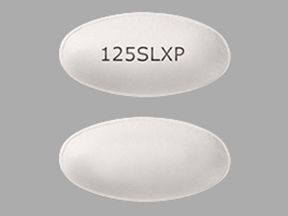Crofelemer (Monograph)
Brand name: Mytesi
Drug class: Antidiarrhea Agents
Chemical name: Oligomeric proanthocyanidin from the latex of Croton lechleri
CAS number: 148465-45-6
Introduction
Antisecretory antidiarrhea agent; oligomeric proanthocyanidin mixture derived from red latex of Croton lechleri tree.
Uses for Crofelemer
Diarrhea
Symptomatic relief of noninfectious diarrhea in adults with HIV infection or acquired immunodeficiency syndrome (AIDS) receiving antiretroviral therapy.
Not indicated for treatment of infectious diarrhea. (See Patients with Infectious Diarrhea under Cautions.)
Crofelemer Dosage and Administration
Administration
Oral Administration
Administer orally twice daily without regard to meals. (See Absorption under Pharmacokinetics.)
Swallow delayed-release tablets whole; do not crush or chew tablets.
Dosage
Adults
Diarrhea
Noninfectious Diarrhea in HIV-infected Patients
Oral125 mg twice daily.
Dosage adjustment not recommended based on CD4+ T-cell count or HIV viral load. (See CD4+ T-cell Count and HIV Viral Load under Cautions.)
Special Populations
Hepatic Impairment
No specific dosage recommendations; dosage adjustments probably not necessary since systemic absorption is minimal.
Renal Impairment
No specific dosage recommendations; dosage adjustments probably not necessary since systemic absorption is minimal.
Geriatric Patients
No specific dosage recommendations at this time; dosage adjustments probably not necessary since systemic absorption is minimal.
Cautions for Crofelemer
Contraindications
-
Manufacturer states none known.
Warnings/Precautions
Patients with Infectious Diarrhea
Not indicated for treatment of infectious diarrhea.
Rule out infectious etiologies of diarrhea prior to initiating crofelemer.
If infectious etiologies not considered and therapy initiated based on presumptive diagnosis of noninfectious diarrhea, those with infectious etiologies may not receive appropriate treatment and their condition may worsen.
CD4+ T-cell Count and HIV Viral Load
Safety profile in HIV-infected patients with baseline CD4+ T-cell counts <404 cells/mm3 is similar to that in those with CD4+ T-cell counts ≥404 cells/mm3.
Safety profile in HIV-infected patients with baseline HIV viral loads ≥400 copies/mL is similar to that in those with HIV viral loads <400 copies/mL.
Specific Populations
Pregnancy
Category C.
Lactation
Not known whether distributed into human milk. Discontinue nursing or the drug.
Pediatric Use
Safety and efficacy not established in pediatric patients <18 years of age.
Geriatric Use
Insufficient experience in patients ≥65 years of age to determine whether they respond differently than younger adults.
Common Adverse Effects
Upper respiratory tract infection, bronchitis, cough, flatulence, increased bilirubin concentrations.
Drug Interactions
Based on in vitro studies, potentially could inhibit CYP3A at concentrations expected in the gut. Inhibition of CYP1A2, 2A6, 2B6, 2C9, 2C19, 2D6, 2E1, and 3A4 in the liver unlikely since systemic absorption is minimal following oral administration. Does not induce CYP1A2, 2B6, or 3A.
Based on in vitro studies, potentially could inhibit multidrug resistance protein (MRP) 2 and organic anion transport protein (OATP) 1A2 at concentrations expected in the gut.
Specific Drugs
|
Drug |
Interaction |
Comments |
|---|---|---|
|
HIV protease inhibitors (PIs) |
Nelfinavir: No effect on systemic exposure to nelfinavir |
|
|
Nucleoside and nucleotide reverse transcriptase inhibitor antiretrovirals (NRTIs) |
Lamivudine: Decreased systemic exposure to lamivudine; not considered clinically important Zidovudine: No effect on systemic exposure to zidovudine |
Crofelemer Pharmacokinetics
Absorption
Bioavailability
Acts locally in GI tract.
Minimal systemic absorption following oral administration in healthy or HIV-infected individuals.
AUC and peak plasma concentration not established because plasma concentrations generally undetectable following oral administration.
Food
Administration with a high-fat meal in healthy individuals did not increase systemic exposure.
Distribution
Distribution not determined.
Extent
Not known whether distributed into human milk.
Elimination
Metabolism
Metabolites not identified in healthy or HIV-infected individuals.
Elimination Route
Not identified in humans.
Half-life
Not established because plasma concentrations generally undetectable following oral administration.
Stability
Storage
Oral
Tablets
20–25°C (may be exposed to 15–30°C).
Actions
-
A botanical drug product; derived from red latex of Croton lechleri Müll. Arg, a tree found in western Amazonian region of South America. Botanical raw material from the tree has been called dragon’s blood (sangre de drago) or tree’s blood (sangre de grado).
-
Oligomeric proanthocyanidin mixture consisting principally of catechin, epicatechin, gallocatechin, and epigallocatechin monomer units linked in a random sequence.
-
Exact mechanism of action in treatment of noninfectious diarrhea not fully elucidated; appears to inhibit both cyclic adenosine-monophosphate (cAMP)-stimulated cystic fibrosis transmembrane conductance regulator (CFTR) chloride ion channel and calcium-activated chloride channel (CaCC) at luminal membrane of enterocytes.
-
CFTR chloride channel and CaCC regulate chloride and fluid secretion by intestinal epithelial cells.
-
Decreases chloride secretion and accompanying high volume water loss resulting in normalization of chloride and water flow in GI tract, decreased stool weight and frequency, and symptomatic relief of diarrhea.
-
Diarrhea in HIV-infected patients can be categorized as infectious (e.g., caused by opportunistic pathogens) or noninfectious (e.g., related to antiretroviral therapy, HIV enteropathy); some noninfectious causes may involve secretory mechanisms.
Advice to Patients
-
Advise patients that crofelemer may be administered without regard to meals.
-
Advise patients that crofelemer delayed-release tablets should be swallowed whole and not crushed or chewed.
-
Importance of women informing clinicians if they are or plan to become pregnant or plan to breast-feed.
-
Importance of informing clinicians of existing or contemplated concomitant therapy, including prescription and OTC drugs, as well as any concomitant illnesses.
-
Importance of informing patients of other important precautionary information. (See Cautions.)
Preparations
Excipients in commercially available drug preparations may have clinically important effects in some individuals; consult specific product labeling for details.
Please refer to the ASHP Drug Shortages Resource Center for information on shortages of one or more of these preparations.
|
Routes |
Dosage Forms |
Strengths |
Brand Names |
Manufacturer |
|---|---|---|---|---|
|
Oral |
Tablets, delayed-release (enteric-coated) |
125 mg |
Mytesi (previously marketed as Fulyzaq) |
Napo |
AHFS DI Essentials™. © Copyright 2024, Selected Revisions April 23, 2020. American Society of Health-System Pharmacists, Inc., 4500 East-West Highway, Suite 900, Bethesda, Maryland 20814.
Reload page with references included
More about crofelemer
- Compare alternatives
- Reviews (1)
- Side effects
- Dosage information
- During pregnancy
- Drug class: antidiarrheals
- En español

